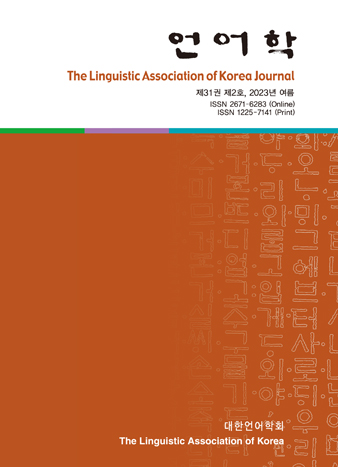대한언어학회 전자저널

31권 2호 (2023년 6월)
- Cyclic Linearization and Edge Effect: A Comparative Analysis Using English and Korean
-
Hoonjoo Ko
Pages : 81-99
Abstract
Ko, Hoonjoo. (2023). Cyclic linearization and edge effect: A comparative analysis using English and Korean. The Linguistic Association of Korea Journal, 31(2), 81-99. This paper provides a comparative analysis of two syntactic approaches, Cyclic Linearization (CL) theory and Edge effect, in the context of English and Korean syntax. We focus on their application to data sets involving structures with multiple specifiers, where the relative status of specifiers is crucial for determining further movement possibilities. The analysis reveals that only the highest edge is available for further syntactic operations. We illustrate our analysis with examples of English and Korean sentences, showing that the extraction of elements from multiple edges is governed by specific syntactic factors. Both CL theory and Edge effect offer explanations for this behavior, but we show that CL theory has limitations in handling certain syntactic structures. In contrast, Edge effect emerges as a more robust and versatile approach, offering a satisfactory explanation for a broader range of syntactic structures across languages. By comparing the applicability and explanatory power of CL theory and Edge effect, this paper contributes valuable insights to the field of syntax, ultimately advocating for Edge effect as a more suitable and economical approach in understanding the mechanisms governing multiple edge extraction and syntactic phenomena across languages. Our findings shed light on the debate over the applicability of these approaches, and we hope that they can inform future research in syntax. The comparative analysis presented in this paper provides a comprehensive understanding of the syntactic behavior of multiple edge extraction in English and Korean, and its implications for syntactic theory.
Keywords
# extractability # multiple edges # cyclic linearization theory # order preservation # edge effect
References
- Bošković, Ž. (2013). Adjectival escapades. In Proceedings of FASL, 21, 1-25.
- Bošković, Ž. (2016). Getting really edgy: On the edge of the edge. Linguistic Inquiry, 47, 1-33.
- Chomsky, N. (2000). Minimalist inquiries: The framework. In R. Martin, D. Michaels & J. Uriagereka, (Eds.), Step by step: Essays on minimalist syntax in honor of Howard Lasnik. Cambridge, MA: MIT Press.
- Chomsky, N. (2001). Derivation by phase. In M. Kenstowicz, (ed.), In Ken Hale: A life in language. Cambridge, MA: MIT Press.
- Chomsky, N. (2008). On phases. In R. Freidin, C. P. Otero, & M.-L. Zubizarreta(ed.), Foundational issues in linguistic theory. Cambridge, MA: MIT Press.
- Davis, C. P. (2021). Possessor extraction in colloquial English: Evidence for successive cyclicity and Cyclic Linearization. Linguistic Inquiry, 52(2), 291-332.
- Fox, D., & Pesetsky, D. (2005). Cyclic Linearization of Syntactic Structure. Theoretical Linguistics, 31(1), 1-45.
- Hiraiwa, K. (2001). Multiple agree and the defective intervention constraint in Japanese. In Proceedings of the HUMIT 2000, MIT Working papers in linguistics 40, 67-80.
- Hiraiwa, K. (2005). Dimensions of symmetry in syntax: Agreement and clausal architecture. Doctoral dissertation, MIT, Cambridge, MA.
- Hiraiwa, K. (2010). Scrambling to the Edge. Syntax, 13, 133-164.
- Hong, K.-S. (1990). Quantifier float in Korean. In Annual Meeting of the Berkeley Linguistics Society, 16, 175-186.
- Koizumi, M. (1995). Phrase structure in minimalist syntax. Doctoral dissertation, MIT, Cambridge, MA.
- Pesetsky, D. (1982). Paths and categories. Doctoral dissertation, MIT, Cambridge, MA.
- Yoo, Y. S. (2019). Mobility in syntax. Doctoral dissertation, University of Connecticut, Storrs, CT.
- Yoo, Y. S. (2021). ECM and Scrambling at the Edges of CP in Korean. Studies in Generative Grammar, 31, 211-226.